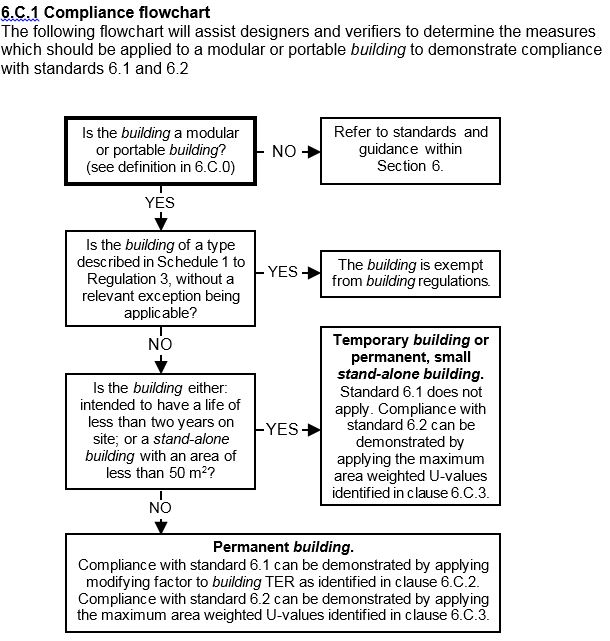Annex 6.C Energy performance of modular and portable buildings
Modular and portable buildings are prefabricated buildings which are designed for delivery to site as sub-assemblies, connected together and completed on site. These buildings can be disassembled into their sub-assemblies when no longer required and transported to another location and reassembled.
Sub-assemblies are clearly identifiable elements manufactured from a number of components but not the components or raw materials themselves. They can be single or multiple volumetric modules or external wall pack modules.
An alternative compliance route is provided to recognise both the common manufacturing base for UK sub-assemblies and the benefits reuse of existing sub-assemblies offers in respect of embodied energy savings (subject to a specified minimum performance).
For the purpose of this guidance, a modular or portable building is defined as a building which has more than 70% of its external envelope created from sub-assemblies. Sub-assemblies can be manufactured and supplied to order, obtained from a centrally held stock or from the disassembly of existing modular buildings on other premises.
This annex provides guidance and offers an alternate means of meeting Standards 6.1 and 6.2, where a building is categorised as a modular or portable building. Reference should be made to the main text within Section 6 (Energy) for application of Standards 6.3 to 6.10.
Note that, where the intended life of such a building is less than 2 years or the building is a stand-alone building having an area less than 50m2, Standard 6.1 does not apply.
The following flowchart will assist designers and verifiers to determine the measures which should be applied to a modular or portable building to demonstrate compliance with Standards 6.1 and 6.2.
6.C.2 Determining the Target Emissions Rate for permanent modular and portable buildings
To enable the continued use of existing stocks of building modules and sub-assemblies, subject to fabric insulation meeting the U-values noted in clause 6.C.3, a modifying factor can be applied to increase the Target Emissions Rating (TER) for the building. Calculate TER as noted in guidance to Standard 6.1 and apply the relevant modifying factor from the table below to give the permitted emissions rate for the modular or portable building.
Table 6.11. TER Modification
| Date of manufacture of module/sub-assemblies | TER modifying factor |
|---|---|
| after 1 October 2015 | 1.00 |
| 1 October 2010 – 30 September 2015 | 1.75 |
| Prior to 1 October 2010 | 2.50 |
For modular or portable buildings, reference should be made to the guidance provided under Standard 6.2, with the exception of area weighted average U-values for a new building or an extension to an existing building. These should be in accordance with the values set out in the table below, in substitution for the corresponding values within tables to clauses 6.2.1 and 6.2.11.
Notes:
This column should also be used for buildings, including extensions, with an intended life of less than two years.
